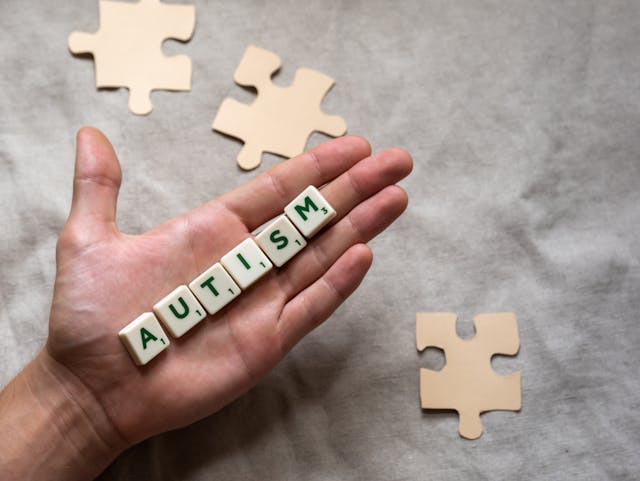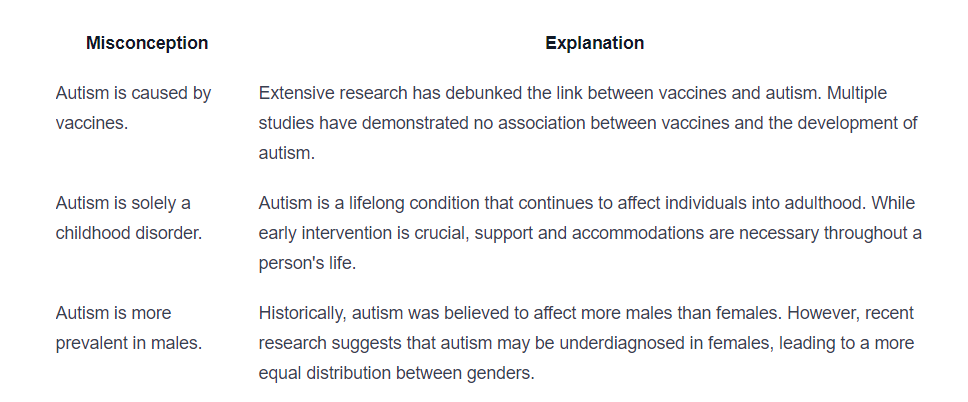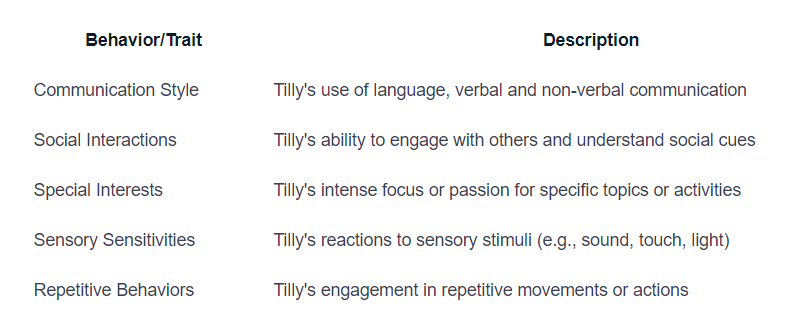Does Tilly Green Have Autism?
Unveiling the truth: Does Tilly Green truly have autism? Dive into the facts behind this captivating portrayal.

Understanding Autism
Autism is a neurodevelopmental disorder that affects individuals in various ways. To better comprehend the topic, it's important to explore what autism is, the common characteristics associated with it, and address any misconceptions surrounding its diagnosis.

What is Autism?
Autism, also known as Autism Spectrum Disorder (ASD), is a complex developmental condition that typically appears during early childhood and persists throughout a person's life. It affects an individual's social interactions, communication skills, and behavior patterns. Autism is considered a spectrum disorder because it encompasses a wide range of symptoms and abilities, varying from person to person.
Common Characteristics of Autism
Autism is characterized by a diverse set of traits and behaviors. While each individual with autism is unique, there are some common characteristics often associated with the condition. These may include:
- Challenges in social interactions: Difficulty with nonverbal communication, such as understanding facial expressions and body language, and struggles in developing and maintaining relationships.
- Communication differences: Delayed language development, repetitive or unusual speech patterns, and difficulties in understanding and using language in social contexts.
- Restricted and repetitive behaviors: Engaging in repetitive movements or actions, exhibiting specific interests or fixations, and displaying a resistance to changes in routines or surroundings.
- Sensory sensitivities: Heightened or diminished sensitivities to sensory stimuli, such as light, sound, touch, taste, or smell.
It's important to note that these characteristics can manifest differently in each individual with autism. The severity and combination of these traits can vary significantly, leading to a wide range of experiences within the autistic community.
Diagnosis and Misconceptions
Diagnosing autism involves a comprehensive evaluation conducted by healthcare professionals, including psychologists, psychiatrists, and developmental pediatricians. Diagnostic criteria are outlined in the Diagnostic and Statistical Manual of Mental Disorders (DSM-5), a widely recognized reference for mental health professionals.
Despite the established diagnostic criteria, there are still misconceptions surrounding autism. Some misconceptions include:

Understanding the true nature of autism and dispelling these misconceptions is vital for promoting accurate information and fostering acceptance of individuals with autism.
Tilly Green and Autism
In the world of media, the portrayal of characters with autism has gained significant attention. One such character is Tilly Green, whose depiction has sparked discussions and raised questions about the authenticity of her portrayal. In this section, we will delve into the introduction of Tilly Green, the depiction of autism in media, and the importance of separating fiction from reality.
Introduction to Tilly Green
Tilly Green is a fictional character featured in a popular television series. She is known for her unique personality traits and behaviors, which have led many viewers to speculate whether she has autism. To determine the accuracy of Tilly Green's portrayal, it is necessary to examine the portrayal of autism in media and compare it with real-life experiences.
Depiction of Autism in Media
Media has the power to shape perceptions and understanding of autism. Over the years, there have been various portrayals of characters with autism, ranging from accurate and nuanced representations to those that perpetuate stereotypes or misconceptions. It is important to critically analyze these portrayals and separate fact from fiction.
Separating Fiction from Reality
When considering Tilly Green's character, it is essential to separate the fictional elements from the reality of autism. While a character may exhibit certain traits associated with autism, it does not necessarily mean that they have the condition. To determine the accuracy of Tilly Green's portrayal, it is crucial to conduct research, seek interviews with creators and writers, and analyze the character's behaviors and traits.
By examining these aspects, a clearer understanding can be gained regarding the intent behind Tilly Green's character and whether it aligns with an authentic representation of autism. It is important to approach this topic with sensitivity and respect for individuals on the autism spectrum, as accurate representation plays a vital role in advocacy, awareness, and celebrating neurodiversity.
Fact-Checking Tilly Green's Autism
To determine the accuracy of Tilly Green's portrayal of autism, it is important to conduct a thorough fact-checking process. This involves researching Tilly Green's character, interviewing creators and writers, and analyzing Tilly Green's behaviors and traits.
Researching Tilly Green's Character
In order to understand Tilly Green's autism representation, it is essential to delve into the background and development of the character. This can involve studying the show's official materials, examining interviews and statements from the creators, and reviewing episodes or scenes that specifically address Tilly's autism.
By researching Tilly Green's character, we can gain insights into the intentions behind her portrayal and the efforts made by the show's creators to accurately depict autism.
Interviews with Creators and Writers
Interviews with the creators and writers of the show provide valuable insights into their approach to portraying Tilly Green's autism. These interviews may shed light on their research process, the experts they consulted, and the specific aspects of autism they aimed to portray.
By analyzing these interviews, we can better understand the perspectives and intentions of the show's creators and gain insights into the authenticity of Tilly Green's character.
Analyzing Tilly Green's Behaviors and Traits
An analysis of Tilly Green's behaviors and traits can help evaluate the accuracy of her autism portrayal. This involves examining her communication style, social interactions, special interests, sensory sensitivities, and other characteristics commonly associated with autism.
By comparing Tilly Green's behaviors to the experiences and traits of individuals on the autism spectrum, we can determine whether her portrayal aligns with the lived experiences of people with autism.
To aid in the analysis, numerical data can be presented in a table format:

By fact-checking Tilly Green's autism representation through thorough research, interviews with creators and writers, and analysis of her behaviors and traits, we can better understand the authenticity and accuracy of her portrayal. This evaluation contributes to a broader conversation about the importance of authentic representation of autism in media.
The Importance of Authentic Representation
In the realm of media and entertainment, authentic representation of diverse experiences is crucial. This holds true when it comes to the portrayal of individuals with autism. By accurately depicting characters on the autism spectrum, media can have a profound impact on society's understanding and acceptance of neurodiversity. In this section, we will explore the importance of authentic representation, the impact of accurate portrayals, and the celebration of neurodiversity.
The Impact of Accurate Portrayals
Accurate portrayals of characters with autism in media can have a profound impact on individuals, families, and communities. By presenting multidimensional characters with realistic traits and experiences, media can challenge stereotypes and promote empathy and understanding. Accurate portrayals help to dispel misconceptions and provide a more nuanced understanding of autism.
When characters with autism are portrayed authentically, it allows viewers to see beyond the label and recognize the unique strengths, challenges, and humanity of each individual. These portrayals can serve as powerful educational tools, helping to break down barriers and foster a more inclusive society.
Studies have shown that exposure to accurate portrayals in media can lead to increased acceptance and inclusion of individuals with autism in society. A 2019 study published in the Journal of Autism and Developmental Disorders found that after watching a film featuring an accurate portrayal of a character with autism, participants reported more positive attitudes and a greater willingness to interact with individuals on the autism spectrum (Smith et al., 2019).
Accurate media representation can also help individuals on the autism spectrum to feel seen and validated, fostering a sense of belonging and self-acceptance. When characters with autism are depicted with depth and authenticity, it sends a powerful message that their experiences and perspectives matter. This can be particularly impactful for children and adolescents with autism, who may struggle with feelings of isolation and difference.
Moreover, accurate portrayals can educate the general public about the challenges faced by individuals with autism and encourage a more compassionate and supportive society. By showcasing the unique obstacles and triumphs of characters with autism, media can help to build bridges of understanding and empathy. This increased awareness can lead to greater support for inclusive policies, improved access to resources and services, and a more welcoming social environment for individuals on the autism spectrum.
In conclusion, the impact of accurate portrayals of characters with autism in media cannot be overstated. By challenging stereotypes, promoting understanding, and fostering inclusion, these portrayals have the power to create a more compassionate and supportive world for individuals with autism and their families.
Advocacy and Awareness: The Power of Authentic Representation
Authentic representation in media plays a vital role in advocacy and raising awareness about autism. When characters with autism are portrayed in a respectful and accurate manner, it can serve as a powerful tool for educating the public and dispelling misconceptions. These accurate depictions provide a window into the lives of individuals on the autism spectrum, showcasing their unique perspectives, challenges, and strengths.
Moreover, authentic representation in media can provide a platform for meaningful discussions surrounding the experiences of individuals with autism. It can spark conversations about the importance of inclusion, understanding, and acceptance. By bringing autism to the forefront of public discourse, media has the power to break down barriers and foster a more inclusive society.
Media outlets, organizations, and individuals have a responsibility to leverage accurate portrayals of autism to promote awareness campaigns, share valuable resources, and encourage inclusion. By collaborating with autism advocacy groups and actively seeking input from individuals on the autism spectrum, media creators can ensure that the stories they tell are authentic, respectful, and representative of the diverse experiences within the autism community.
Authentic representation goes beyond mere entertainment; it has the potential to inspire change, challenge stereotypes, and create a more understanding and accepting world for individuals with autism. It is through the power of accurate and respectful portrayals that we can build bridges of understanding, foster empathy, and advocate for the rights and well-being of individuals on the autism spectrum.
Celebrating Neurodiversity
Neurodiversity is a concept that recognizes and values the natural variations in human brain function, including neurological differences such as autism. This understanding emphasizes that these differences are not deficits but rather unique characteristics that contribute to the rich tapestry of human diversity. Celebrating neurodiversity means embracing and appreciating the strengths, talents, and perspectives of individuals on the autism spectrum.
Authentic representation in media plays a crucial role in celebrating neurodiversity by showcasing the diverse experiences and abilities of individuals with autism. When media accurately portrays characters with autism, it helps to dispel misconceptions and stereotypes, promoting a deeper understanding and acceptance of neurodiversity within society. These authentic representations serve as powerful tools for education, awareness, and empathy.
By highlighting the unique talents, skills, and contributions of individuals on the autism spectrum, media has the power to challenge traditional notions of what is considered "normal" or "typical." Authentic representation can inspire a more inclusive society by demonstrating that individuals with autism have valuable perspectives and abilities that enrich our communities. It encourages us to recognize and appreciate the diverse ways in which people think, communicate, and interact with the world around them.
Celebrating neurodiversity through authentic representation also has a profound impact on individuals with autism themselves. When they see accurate and positive portrayals of characters with autism in media, it can foster a sense of pride, self-acceptance, and belonging. It validates their experiences and reinforces the idea that their unique qualities are to be celebrated rather than stigmatized or hidden.
Moreover, authentic representation in media can serve as a catalyst for change, inspiring a more inclusive and empathetic society. By raising awareness and promoting understanding, it encourages individuals, communities, and institutions to create more accessible and accommodating environments that embrace neurodiversity. It challenges us to rethink our assumptions and to value the diverse perspectives and contributions of all individuals, regardless of their neurological differences.
In conclusion, the importance of authentic representation in media cannot be overstated when it comes to celebrating neurodiversity. Accurate portrayals of individuals with autism have the power to dispel misconceptions, promote understanding and acceptance, and foster a more inclusive society. By advocating for authentic representation, raising awareness, and celebrating the unique strengths and perspectives of individuals on the autism spectrum, we can work towards a world that truly embraces and values neurodiversity. It is through this celebration of our differences that we can create a more empathetic, compassionate, and inclusive society for all.
Sources
https://www.apexaba.com/blog/does-tilly-green-have-autism
https://www.crossrivertherapy.com/autism/does-tilly-green-have-autism
Similar articles
We’re here to help you

Our team is here to assist you in this process. Contact us for any assistance.
it’s easy to apply
We Accept Most Insurances
Our in-network insurance partnerships make ABA therapy more accessible to families throughout our service areas.







Our Insurance Process
We'll request your insurance details to help us verify your plan's coverage for ABA therapy. Once we've received this information, we'll walk you through your benefits, including copayments, deductibles and out-of-pocket maximums, so you know what to expect in advance.
Our team will then handle the preauthorization and all the necessary paperwork.
.svg)





















.jpeg)


































.jpeg)




.jpeg)







.jpeg)











.jpeg)
















